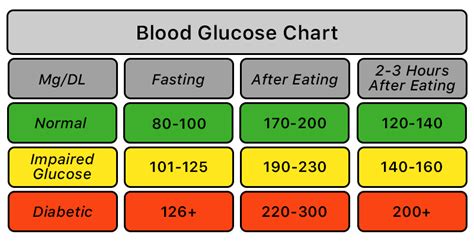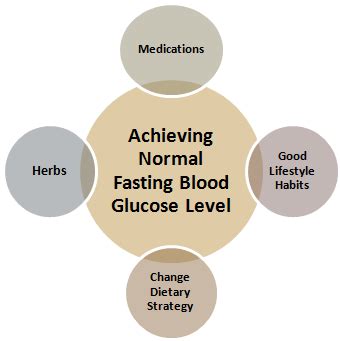Intro
Discover 5 ways to maintain normal fasting glucose levels, managing blood sugar, insulin sensitivity, and diabetes prevention through healthy diet, exercise, and lifestyle changes.
Maintaining normal fasting glucose levels is crucial for overall health, as it helps prevent the onset of diabetes and other metabolic disorders. Fasting glucose levels indicate the amount of glucose in the blood after an overnight fast, and normal levels typically range from 70 to 99 mg/dL. Abnormal fasting glucose levels can be a sign of insulin resistance, a precursor to type 2 diabetes. Therefore, it is essential to understand the importance of maintaining normal fasting glucose levels and the ways to achieve this.
The human body relies on glucose as a primary source of energy, and the pancreas regulates glucose levels by producing insulin, a hormone that facilitates glucose uptake in cells. When fasting glucose levels are within the normal range, it indicates that the body is effectively regulating glucose metabolism. On the other hand, elevated fasting glucose levels can lead to serious health complications, including cardiovascular disease, nerve damage, and kidney damage. Hence, it is vital to maintain normal fasting glucose levels through a combination of lifestyle modifications and medical interventions.
Understanding the factors that influence fasting glucose levels is crucial for developing effective strategies to maintain normal levels. Factors such as diet, physical activity, stress, and sleep patterns can significantly impact fasting glucose levels. For instance, a diet high in refined carbohydrates and sugar can lead to insulin resistance, causing fasting glucose levels to rise. Similarly, a sedentary lifestyle and chronic stress can also contribute to elevated fasting glucose levels. By recognizing these factors, individuals can take proactive steps to maintain normal fasting glucose levels and reduce the risk of developing related health complications.
Understanding Normal Fasting Glucose Levels

Normal fasting glucose levels are typically defined as levels between 70 and 99 mg/dL. Levels below 70 mg/dL may indicate hypoglycemia, a condition characterized by abnormally low blood glucose levels. On the other hand, levels above 99 mg/dL may indicate hyperglycemia, a condition characterized by abnormally high blood glucose levels. The American Diabetes Association recommends that adults without diabetes should aim for a fasting glucose level below 100 mg/dL. Individuals with diabetes should aim for a fasting glucose level between 80 and 130 mg/dL, depending on their individual treatment goals.
Factors Influencing Fasting Glucose Levels
Several factors can influence fasting glucose levels, including diet, physical activity, stress, and sleep patterns. A diet high in refined carbohydrates and sugar can lead to insulin resistance, causing fasting glucose levels to rise. Similarly, a sedentary lifestyle and chronic stress can also contribute to elevated fasting glucose levels. Other factors, such as certain medications, hormonal imbalances, and sleep disorders, can also impact fasting glucose levels. By understanding these factors, individuals can take proactive steps to maintain normal fasting glucose levels and reduce the risk of developing related health complications.Strategies for Maintaining Normal Fasting Glucose Levels

There are several strategies that can help maintain normal fasting glucose levels. These include:
- Eating a balanced diet that is low in refined carbohydrates and sugar
- Engaging in regular physical activity, such as walking or jogging
- Practicing stress-reducing techniques, such as yoga or meditation
- Getting adequate sleep each night
- Avoiding certain medications that can raise blood glucose levels
- Monitoring fasting glucose levels regularly to detect any changes or abnormalities
Benefits of Maintaining Normal Fasting Glucose Levels
Maintaining normal fasting glucose levels has numerous benefits, including reducing the risk of developing type 2 diabetes, cardiovascular disease, and other metabolic disorders. Normal fasting glucose levels also indicate that the body is effectively regulating glucose metabolism, which can improve overall health and well-being. Additionally, maintaining normal fasting glucose levels can help prevent complications associated with diabetes, such as nerve damage, kidney damage, and blindness.5 Ways to Achieve Normal Fasting Glucose Levels

Here are five ways to achieve normal fasting glucose levels:
- Eat a Balanced Diet: Eating a balanced diet that is low in refined carbohydrates and sugar can help maintain normal fasting glucose levels. Focus on whole, unprocessed foods, such as fruits, vegetables, whole grains, lean proteins, and healthy fats.
- Engage in Regular Physical Activity: Regular physical activity, such as walking or jogging, can help improve insulin sensitivity and reduce fasting glucose levels. Aim for at least 150 minutes of moderate-intensity aerobic exercise per week.
- Practice Stress-Reducing Techniques: Chronic stress can raise fasting glucose levels, so practicing stress-reducing techniques, such as yoga or meditation, can help maintain normal levels.
- Get Adequate Sleep: Getting adequate sleep each night is essential for maintaining normal fasting glucose levels. Aim for 7-9 hours of sleep per night and establish a consistent sleep schedule.
- Monitor Fasting Glucose Levels: Monitoring fasting glucose levels regularly can help detect any changes or abnormalities. Use a glucose meter to track fasting glucose levels and consult with a healthcare provider if levels are outside the normal range.
Common Mistakes to Avoid
When trying to maintain normal fasting glucose levels, there are several common mistakes to avoid. These include: * Consuming high amounts of refined carbohydrates and sugar * Leading a sedentary lifestyle * Not getting enough sleep * Not monitoring fasting glucose levels regularly * Not seeking medical attention if fasting glucose levels are outside the normal rangeConclusion and Next Steps

In conclusion, maintaining normal fasting glucose levels is crucial for overall health and well-being. By understanding the factors that influence fasting glucose levels and implementing strategies to maintain normal levels, individuals can reduce the risk of developing related health complications. Remember to eat a balanced diet, engage in regular physical activity, practice stress-reducing techniques, get adequate sleep, and monitor fasting glucose levels regularly. If you have concerns about your fasting glucose levels or would like to learn more about maintaining normal levels, consult with a healthcare provider or a registered dietitian.
What are normal fasting glucose levels?
+Normal fasting glucose levels are typically defined as levels between 70 and 99 mg/dL.
What factors can influence fasting glucose levels?
+Factors such as diet, physical activity, stress, and sleep patterns can influence fasting glucose levels.
How can I maintain normal fasting glucose levels?
+Maintaining normal fasting glucose levels can be achieved by eating a balanced diet, engaging in regular physical activity, practicing stress-reducing techniques, getting adequate sleep, and monitoring fasting glucose levels regularly.
We hope this article has provided you with valuable information on maintaining normal fasting glucose levels. If you have any further questions or concerns, please do not hesitate to comment below. Share this article with your friends and family to help them understand the importance of maintaining normal fasting glucose levels. Take the first step towards a healthier lifestyle by implementing the strategies outlined in this article. Remember, maintaining normal fasting glucose levels is crucial for overall health and well-being, and it's never too late to make a positive change.
